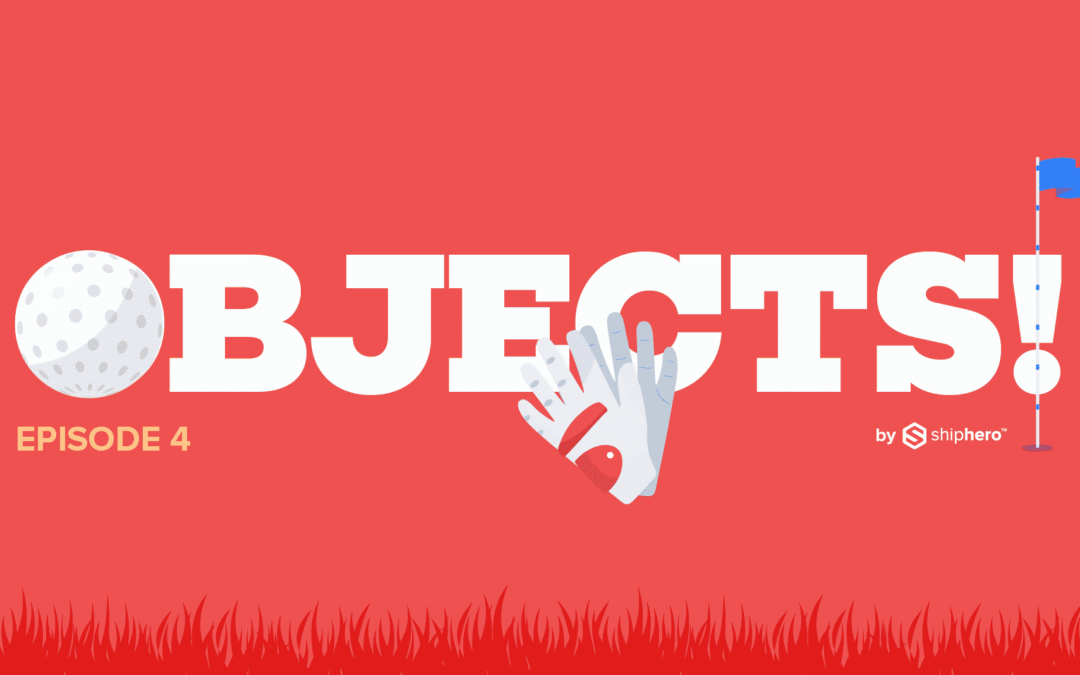
Mar 8, 2021 | Blog, Podcast, Warehouse Management Software
About the Podcast
Objects! with ShipHero talks with the entrepreneurs, innovators and idealists that put items on the shelf and bring packages to your doorstep. From hot sauce to board games, toothbrushes to frying pans, startup side-gigs to enterprise players, join ShipHero founder, Nicholas Daniel-Richards, as he demystifies the manufacturing and logistics behind some of our most beloved household objects, with transformational ideas that are guaranteed to make you say, why didn’t I think of that?. This fast-paced and intriguing podcast covers thousands of travelled miles in less than an hour, so next time you’re standing in your local store and see a label that says ‘Made in <A Land Far, Far Away>’, you’ll know just how it got into your hands.
If you are a successful entrepreneur looking to grow or an aspiring innovator with an idea, Objects! with ShipHero provides a detailed, 360° exploration with the masterminds behind modern ecommerce and shipping solutions. So settle in, buckle up, and prepare to get objectified! … no wait, not that. Get ready to say “I objects!”… we’ll work on it. Available on Spotify, iTunes and at this link.
Episode Introduction
Episode FORE of Objects! with ShipHero gets into the rough business of golf gloves, as we’re joined by Adam Karger and his company Scotch & Skins — a brand dedicated to upping your golf game with premium leather golf gloves and other high-end golf accessories.
“True differentiation didn’t have to be about being so different from everyone else, but rather celebrating really good materials– really amazing, natural materials. And this glove did that… and so we found a little bit of our voice.” — Adam Karger, co-founder of Scotch & Skins
As a tech consultant by day, an entrepreneur by night, and a new father around the clock, Adam shares his journey of designing and manufacturing a high-quality golf glove from scratch, with absolutely zero prior knowledge of making or selling gloves.
So how do you start a business selling a product you don’t know how to make? Join us as we learn how Adam, armed with only a laptop and an idea, forged the right partnerships to create his brand Scotch & Skins, set to tee off in the spring of 2021. (Already nauseous of these golf puns? Don’t worry there isn’t any more).
All Businesses Start With a Little Drive
Although he started as a novice in the manufacturing and design of golf gloves, Adam Karger is no amatuer in the golf world. Adam played Division 1 Golf at Colgate University and in his Senior year competed in five tournaments, posting a scoring average of 83.2.
Adam and his co-founder and friend, Bryce, had toyed around with the idea of vintage-style golf gloves for some time. With no prior experience, the road seemed long and challenging, and a lot of questions stood in his way like, how do you find a manufacturer? How do you design and get tech specs? How do you ensure quality? How do you source the leather?… to name a few.
But like all journeys, Adam began with a single, brave step towards his new future, after a couple beers with his friend of course.
“For me, it was a really interesting problem to solve. Because, I think when you’re building a company or a brand or a product, really it’s just solving a bunch of little questions, and the amalgamation of those answers turn into the go/no go of building a product or a brand” — Adam Carger
Where did Adam turn for the answers to these problems? Why, Google of course. The start of Adam’s journey was typing phrases “glove designer” and “glove manufacturer” into a publicly available search engine… Here he proved that there is no secret to success other than persistence, perseverance, and a little drive. (last one ;-p)
Play To Your Handicap
Adam’s philosophy of “partner with people who have the superpowers that you don’t” led him to Greg, a glove consultant with years of experience making all types of gloves, except golf gloves. Excited to work on a new project, Greg agreed to consult and Adam began to grow his team.
The first superpower Greg brought to the table was his large network of manufacturers, which they were able to whittle down to a few choices and eventually settle on a Connecticut-based leather manufacturer.
Currently, Adam’s home will be the fulfillment hub due to the minimum required investment and full control of the packing and boxing customization. In the spirit of partnering with people who have superpowers they don’t, Adam set the goal for his company to eventually work with a 3PL like ShipHero, because reaching that point means the company has gotten big enough to where order fulfillment takes up too much time and a 3PL partner is needed to help your business scale.
Avoid the Sandtraps
Golf gloves are typically made of natural leather or a synthetic substitute, so the question was which material was better for their business? With this first decision, Adam and Bryce decided that whenever they came to a similar fork in the road, they were going to take the path towards high-quality materials.
But, where would their journey’s excitement be without hitting the hazards early on? They wanted to use real leather, and golf gloves are typically made using Cabretta leather (not actually leather) because it is thin, form-fitting and “soft as butter”.
In hopes to stand out from this tradition, Adam and Bryce found an Australian distributor for kangaroo leather… and when the prototype was complete, they immediately realized their massive mistake. The kangaroo leather was extremely poorly suited for a golf glove, because the leather was not thin enough or flexible enough to be useful on the golf course. Luckily, they had a mulligan.
Their glove consultant Greg recommended UK-based Pittards, a top manufacturer of Cabretta leather with over two centuries of experience. A month after the kangaroo catastrophe, their next set of Cabretta leather golf gloves were a hole-in-one: thin, form-fitting, and supple. With this, Adam and Bryce realized that differentiating your brand doesn’t need to lead you down a difficult path; rather, choosing to celebrate really good materials is a way to differentiate in and of itself.
The Back 9
“We’ve evolved over time, but it makes you appreciate where you are when you think of where you started.” — Adam Carger
Adam found that being laser-focused on their first product allowed them to bring one high-quality and thoughtful product to the market and helped them to determine their company’s manufacturing principles. They then applied what they learned to making their Cabretta leather ball markers and North American hickory alignment sticks with covers made from North American leather from North American tanneries. How boujee.
Officially teeing off in the spring of 2021, Scotch & Skins is currently going through the final process of creating sizes, finalizing logo design, and will go into full-scale manufacturing soon with their premium golf gloves and assortment of high-end golf accessories.
So remember… if the glove don’t fit, you must not have shopped Scotch & Skins.
And be sure to check out https://www.scotchandskins.com/ and join their email list to be notified of product release.
How About You?
Have you been sketching the next big thing on the back of a cocktail napkin? Are you frantically Googling everything about it right now? Now, right now, is the time to make it happen. There’s loads of tools and resources available everywhere to convert the idea in your head into an OBJECT! on the shelf. All it takes is a little follow through. ⛳️
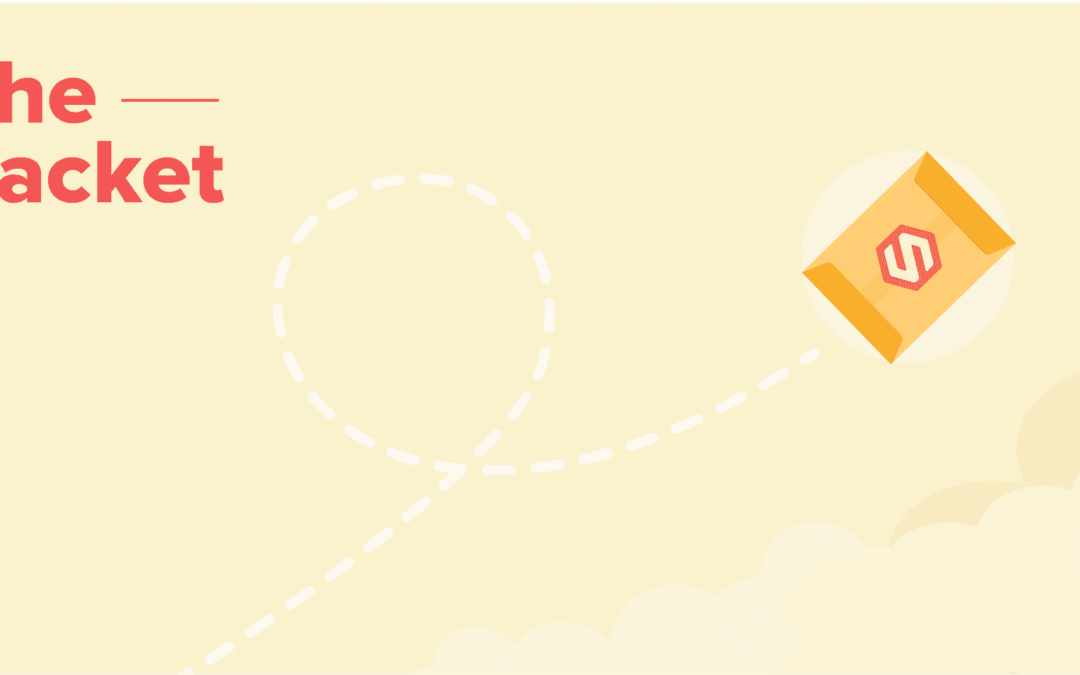
Mar 5, 2021 | Blog, The Packet
Front and Center
Shipping’s Decarbonization Starts Now
Sustainability has reared its beautiful head towards the supply chain industry, and started with its biggest polluter, ocean shipping. In what has been dubbed shipping’s decarbonization ‘moonshot’, a $5 billion proposal has been formally sent to the International Maritime Organization (IMO), calling for mandatory contributions from every shipping company in the world at approximately $2 per tonne of bunker fuel.
The proposal, backed by all major global shipping associations, aims to quickly advance R&D for zero-carbon maritime technologies and the development of working prototypes, as well as CO2 reduction projects in developing countries.
In a joint press release from nine of the world’s largest global shipping companies, they state “zero-carbon technologies do not yet exist that can be applied at scale to large ocean-going ships. A well-funded R&D programme, which the industry has agreed to pay for within a global regulatory framework, needs to commence immediately under the supervision of the UN IMO.”
Don’t Call It a Tax
Since the European Parliament voted to include the shipping industry in their 2022 carbon market, and also backed a -40% greenhouse gas efficiency target to be reached by 2030, the US and China have also been evaluating similar emissions trading schemes.
Shipping associations hope that this proposal will curtail regional legislation efforts that would impose higher carbon taxes and more stringent regulation. Some environmental groups have claimed that this “moonshot” and $5 billion figure is much too small, and merely a tactic to avoid government interference
IT’S HAPPENING!
Yes, it is. With this proposal, the shipping industry must pay, one way or another, for their carbon footprint. It won’t be long for the spotlight to shine on the rest of the supply chain, and it is put under the same scrutiny as shipping. The proposal backers hope to get it ratified at the next IMO’s Marine Environment Protection Committee (MEPC) later this year. If you haven’t already looked at the sustainability of your supply chain, now is the time.
Back of the Packet
Sweet Relief Package
On Wednesday, the final version of President Biden’s $1.9 trillion coronavirus relief bill (AKA the American Rescue Plan Act) was approved by the House and sent to Biden’s desk for signature.
The American Rescue Plan will send $1,400 in direct payments to those with an annual salary up to $75,000, and it also includes:
- $350 billion for state and local governments aid
- $14 billion towards vaccine distribution
- $130 billion to schools for safe reopening
- $300 billion in weekly jobless benefits through September
- Expanded tax credit of up to $3,600 per child, which could raise 4 million children out of poverty.
Aaahhhh, sweet economic stabilization.
Unwelcome to Walmart
Walmart announced that they will be repurposing one North Dallas location into a fulfillment center dedicated entirely to online delivery and curbside pickup, with no more in-store shopping. As a proverbial canary in the low-price coal mine, this could signal a permanent shift towards local delivery and curbside pickup over conventional brick-and-mortar shopping.
Continuing their effort to modernize and keep up with eCommerce culture, Walmart has begun offering free samples with their grocery pick-up and also for customers that sign up for the Walmart+ subscription service.
Buddha-ful Statue
What’s trending on China’s online shopping platform Taobao? A statue of Trump as Buddha with the slogan ‘make your company great again’, of course! A Trump toilet brush is also among Taobao’s top-rated Trump-related merchandise.
ShipHero News
Episode FORE: Objects! With ShipHero
Quiz for the true golfers: Cabretta leather is obviously the key ingredient for golf gloves… but did you know it’s not actually leather? Learn with us on Episode FORE of Objects! with ShipHero the rough business of golf gloves with Adam Karger, co-founder of Scotch & Skins. And remember: if the glove don’t fit, you must check out Scotch & Skin’s line of premium golf gloves and accessories.
Influencer’s Guide to Becoming a CEO
Success stories of influencers turned CEO exemplify the new American Dream. Just look at our adorable canine friend Humphrey and his owner’s brand, Spotted by Humphrey! Learn how to monetize your brand and engage with your audience with The Influencer’s Guide: How to Become a CEO Using Private Labelling.
ShipHero’s Innovation Wheel: Sustainable Fulfillment
Does Greta Thunberg haunt your dreams? Maybe it’s time your business starts cutting down its packaging and supply chain waste. Learn how with ShipHero’s Fulfillment Innovation Wheel series — Sustainable Fulfillment.
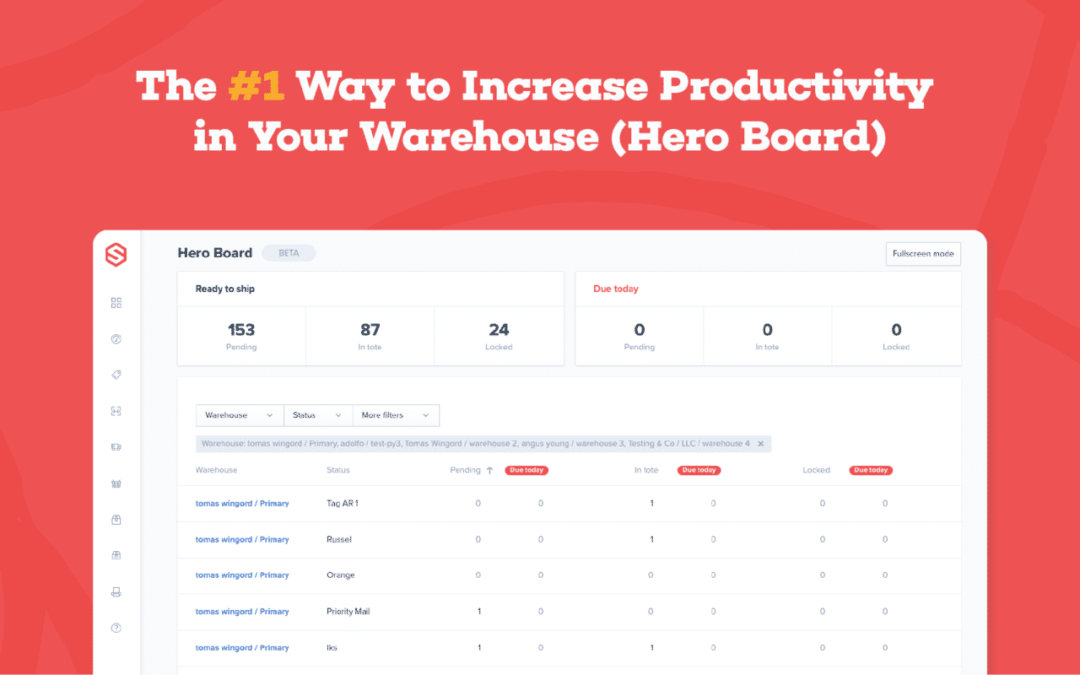
Mar 4, 2021 | Blog, Warehouse Operations
Want to know the most effective and the most important step towards optimizing your warehouse output?
There are plenty of opinions on the internet from reliable experts, with “50+ tips for warehouse efficiency”, that cover resolving certain issues or improving minor practices, but we wanted to cut through the noise to find the ONE suggestion that will have the most impact on your supply chain, inventory management and order fulfillment.
We searched for the single pearl of wisdom amongst many best practices and our own warehousing innovations. Notable suggestions to boost warehouse productivity included:
- Create a picking path by location
- Organize bins by popularity
- Separate bulk items from small picks
- Optimize stocking levels for easy inventory rotation
- Incorporate employee feedback to identify bottlenecks
- Reserve capacity for last-minute emergencies
- Track shipping status to predict inventory requirements
While effective, each of the aforementioned suggestions rely on one major capability, and without it, your supply chain will NEVER improve productivity. So, what is the #1 capability for improving your warehouse productivity?
Measure & Benchmark Your Supply Chain
Simply put, your business must have the right tools in place to measure and access vital data relating to the productivity of your warehouse in each departmental area. The quality of the information you receive directly impacts how effectively you set realistic productivity goals and speed up work pace in a sustainable manner.
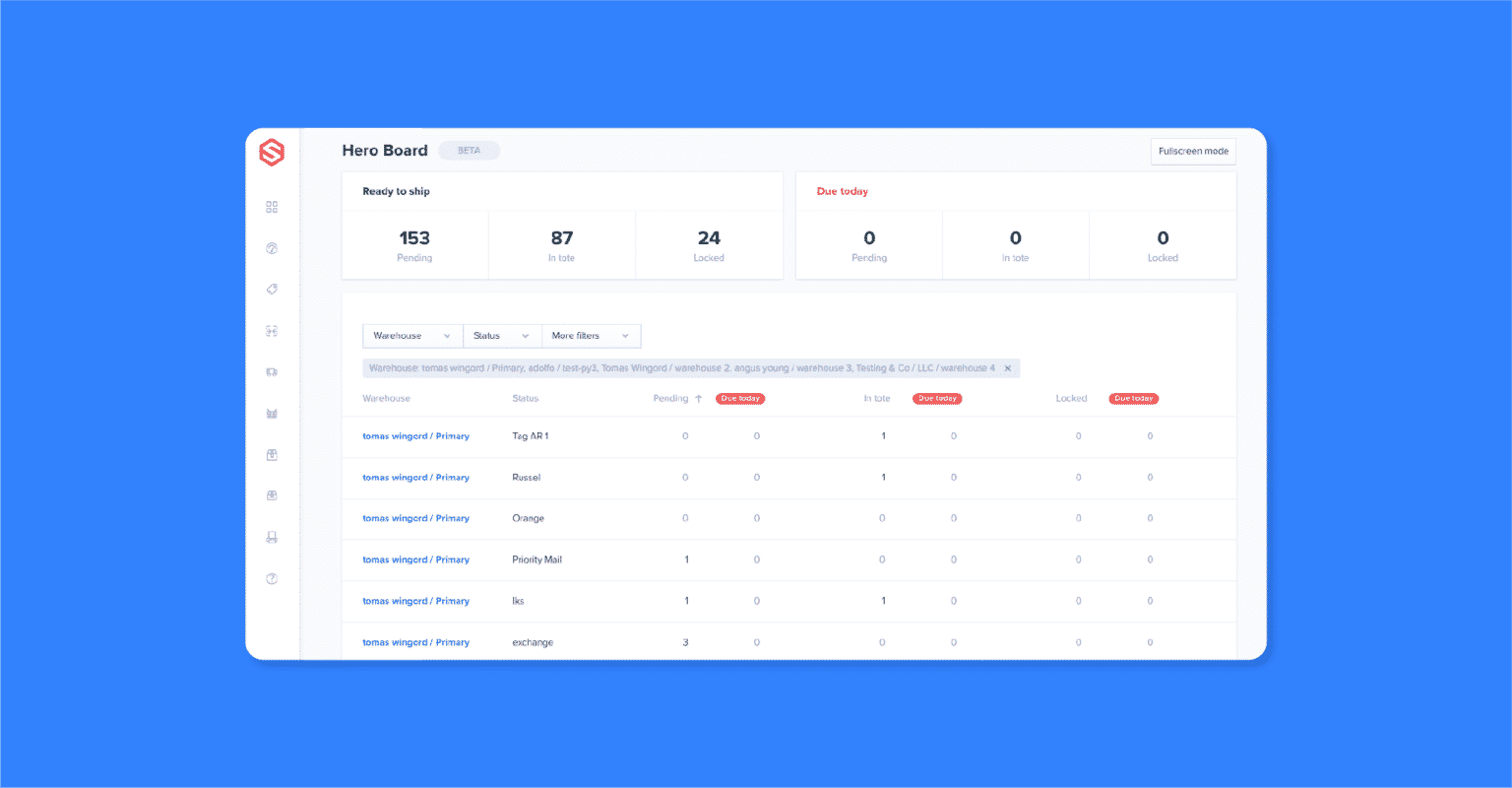
Picking, packing, and inventory replenishment are the three areas of focus when beginning to make systemic improvements to your warehouse. It’s important not to measure everything at once; rather, start by identifying your biggest cost-drivers or bottlenecks and address those first, such as labor hours, units of work, etc. In each area of focus, ask yourself the following questions:
Picking
Picking is the process of walking through the warehouse and selecting products that constitute one or more orders. You can begin measuring this process by asking the following:
- Picking time and routes: Do you know how long it takes to pick items and complete orders? What routes to pickers take? Are picking routes efficient?
- Worker productivity: Who are the workers that are more productive and less prone to errors? Are you compensating these workers accordingly? Are you properly staffed?
- Warehouse layout: What are your most-picked products or combination of products? Do you adjust SKUs based on sales velocity to reduce picking time?
- Employee suggestions: Are you listening to your employees? Do you have a place to log their suggestions and take action?
Packing
Packing is the process of verifying the order contents and putting the ordered items into the shipping package. You can begin measuring this process by asking the following:
- Overall evaluation: Every operation is different. What are the major factors that make or break the speed of your packing operation?
- Workstation design: Is your workstation designed as efficiently as possible? Are there improvements to be made to the top size or worker spacing?
- Material availability: Are cartons, inserts, and any personalization items available and sufficiently stocked at each station?
- Automation opportunity: Are there processes that can be automated, such as envelope insertion, box building, etc.
- Employee suggestions: Are you listening to your employees? Do you have a place to log their suggestions and take action?
Inventory Replenishment
Inventory replenishment is the process of restocking bins with products so that orders can be picked, and errors in replenishment can result in serious cascading bottlenecks in the picking and packing processes. You can begin measuring this process by asking the following:
- Replenishment levels: What inventory levels trigger your restocking process? Are these built to scale with bulk orders?
- Distribution duration: Is your replenishment process intelligently informed by manufacturing and distribution times? Does your network of warehouses communicate to overcome any unexpected shortages?
- Employee suggestions: Are you listening to your employees? Do you have a place to log their suggestions and take action?
The most efficient supply chains run on information. The key to improving warehouse productivity is asking the right questions, measuring the actual outcome, and planning for incremental improvements. Without measurements and benchmarks, you will be stuck reacting to issues, rather than proactively planning and systematically working towards a better warehouse.
ShipHero’s HeroBoard
ShipHero WMS constantly strives to provide you with the information that you need to make intelligent decisions regarding your warehouse management and order fulfillment. That’s why we built the HeroBoard — a personalized dashboard designed to give an at-a-glance view of your fulfillment operations.
The HeroBoard overview dashboard refreshes every 30 seconds for real-time monitoring of your shipments. Want to get into the specifics? HeroBoard users can easily drill down into specific order information for better customer service and flexible decision-making.
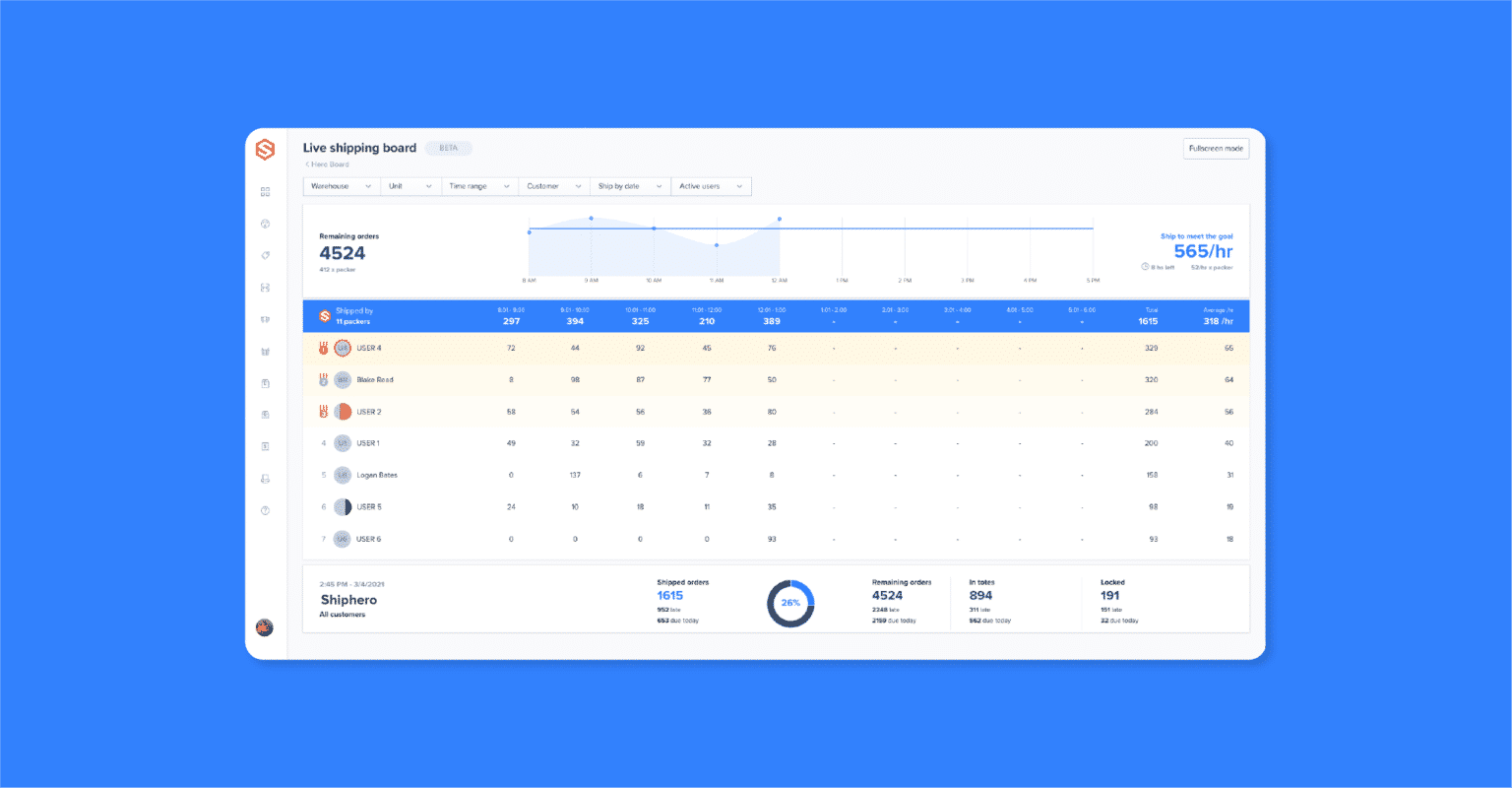
The Live Shipping Board is the newest update to the HeroBoard that gives you a view into the stats for each packer, remaining orders, and more!
Schedule a demo today.
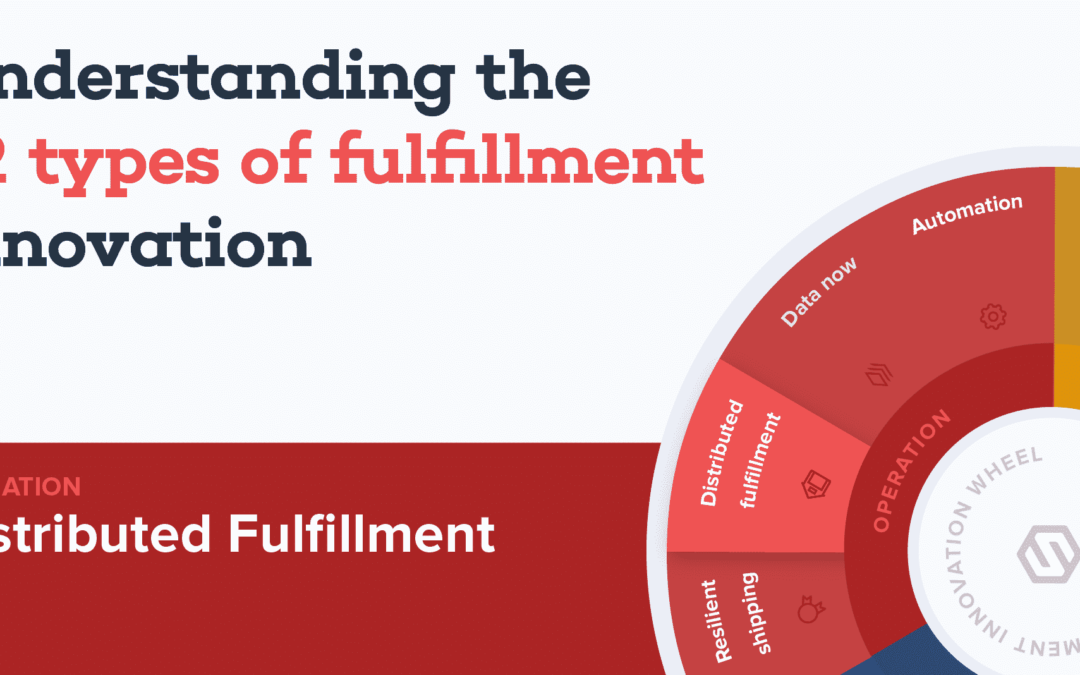
Mar 3, 2021 | Blog, Fulfillment, The Fulfillment Innovation Wheel
ShipHero recently launched The Fulfillment Innovation Wheel to help 3PLs understand what capabilities and service offerings they need to implement in order to be successful and to help online retailers and brands choose which 3PL is right for them by allowing them to ‘check the boxes’.
The Fulfillment Innovation Wheel listed a set of twelve (12) capabilities that fulfillment providers and logistics companies should implement to continually delight their customers and push themselves towards greater success and innovation.
The twelve capabilities are:
- 2-Day Delivery
- Same Day Shipping
- At the Box Personalization
- Designed for Returns
- Sustainable Fulfillment
- Resilient Shipping
- Distributed Fulfillment
- Data Now
- Automation
- Scale Up and Out
- Integration Stack
- Professional Services
In this article, we will be diving into Capability #7: Distributed fulfillment.
And be sure to stay tuned for future articles as we deep-dive into each capability.
Capability #7: Distributed Fulfillment
Quiz for the e-commerce gurus out there. Which of these two options makes more sense from a business standpoint: Deliver your products from nearby OR deliver your products from far away? Take your time, we all don’t have MBAs.
Businesses who want to reduce delivery times and keep costs low will opt to deliver their products from a nearby location, but as an online business reachable by customers all over the United States, how is that possible? The solution: Distributed Fulfillment.
Distributed Fulfillment is the secret to how the e-commerce giants can deliver free 1-2 day shipping nationwide, and the concept is simple: intelligently bring inventory and fulfillment centers closer to your customers.
The advantages of distributed fulfillment are:
Optimized Price and Delivery Speed
Reducing the distance between fulfillment centers and your customer’s doorstep leads to lower costs, faster delivery times, and reduced carbon emissions. This also allows your business to offer free shipping or guaranteed two-day shipping, which are huge online purchase drivers and pretty much the standard in today’s market.
Easy to Manage
With the right tools in place, managing your inventory is simple. Warehousing companies and fulfillment providers like ShipHero offer Warehouse Management Software (WMS) to give business owners complete oversight and control into their supply chain, so that they can make intelligent decisions on where to store their inventory and how to ship their product.
Reliable and Resilient Shipping
Don’t be at the mercy of mother nature or shipping bottlenecks from traditional carriers. Distributed fulfillment gives you a diversified and robust supply chain that you and your customers can rely on to ship, no matter the circumstance.
In-House vs. Outsourced
For all these reasons, e-commerce giants like Amazon and Walmart are successfully employing this logistics model for e-commerce fulfillment and retailers that piggyback off of their distributed fulfillment network seeing fantastic results.
For in-house fulfilment (i.e., creating a fulfillment network yourself), a high amount of initial capital is required to lease warehouse space across the country, distribute the inventory, then continuously monitor and optimize your inventory management and order fulfillment.
Luckily for small to medium-sized businesses looking to compete, 3PLs and outsourced fulfillment providers like ShipHero are creating massive distributed fulfillment networks around the country, and are ready to deliver your e-commerce.
Our customers love that ShipHero can easily offer 2-day shipping anywhere in the contiguous United States at simple and transparent pricing. We are also able to prioritize ground shipping, making for a resilient and eco-friendly supply chain. We attribute this success on the Fulfillment Innovation Wheel to Capability #7: Distributed Fulfillment.
Stay tuned next as we cover Capability #7: Resilient Shipping! Viva la Resilience. ShipHero.
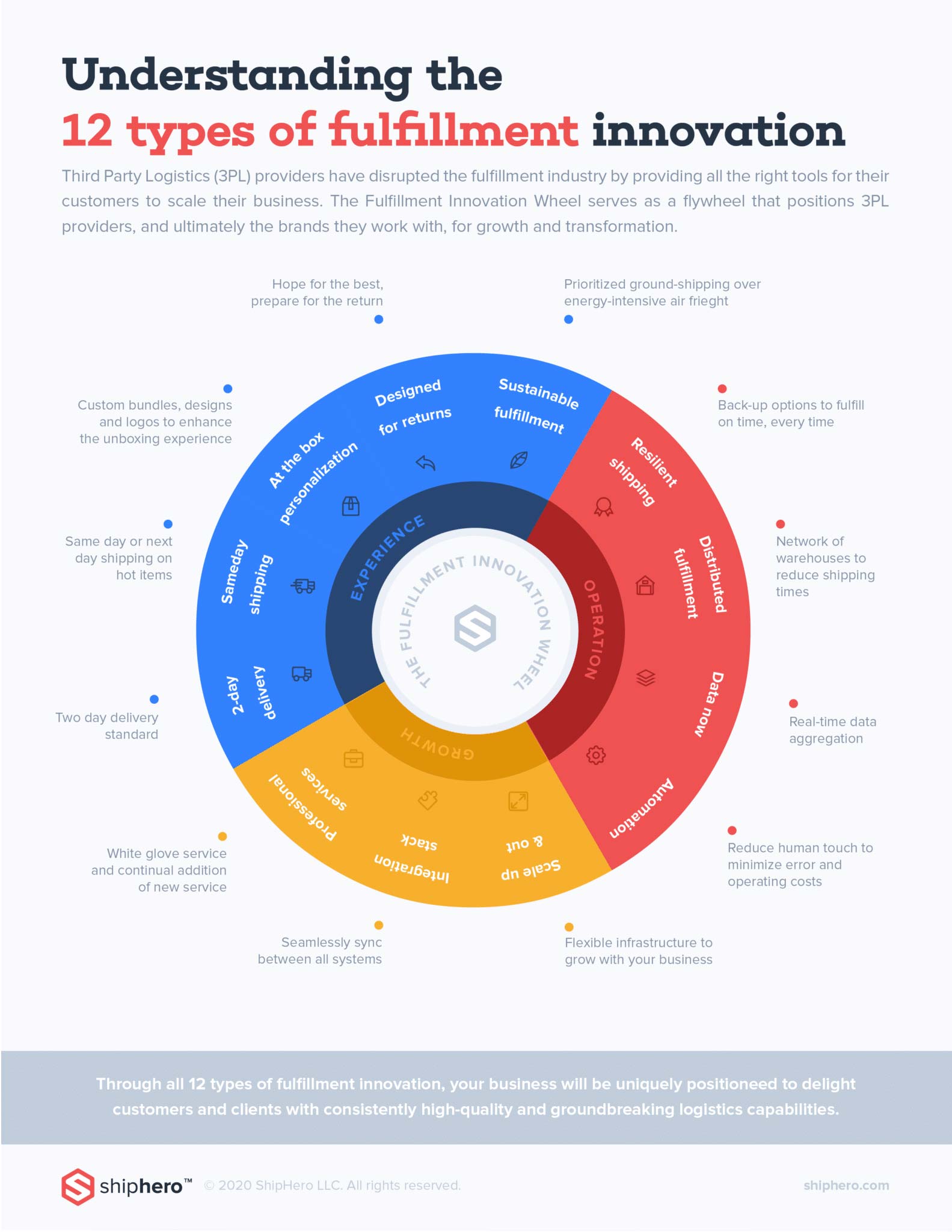
Learn more about ShipHero’s industry-leading warehouse management software.
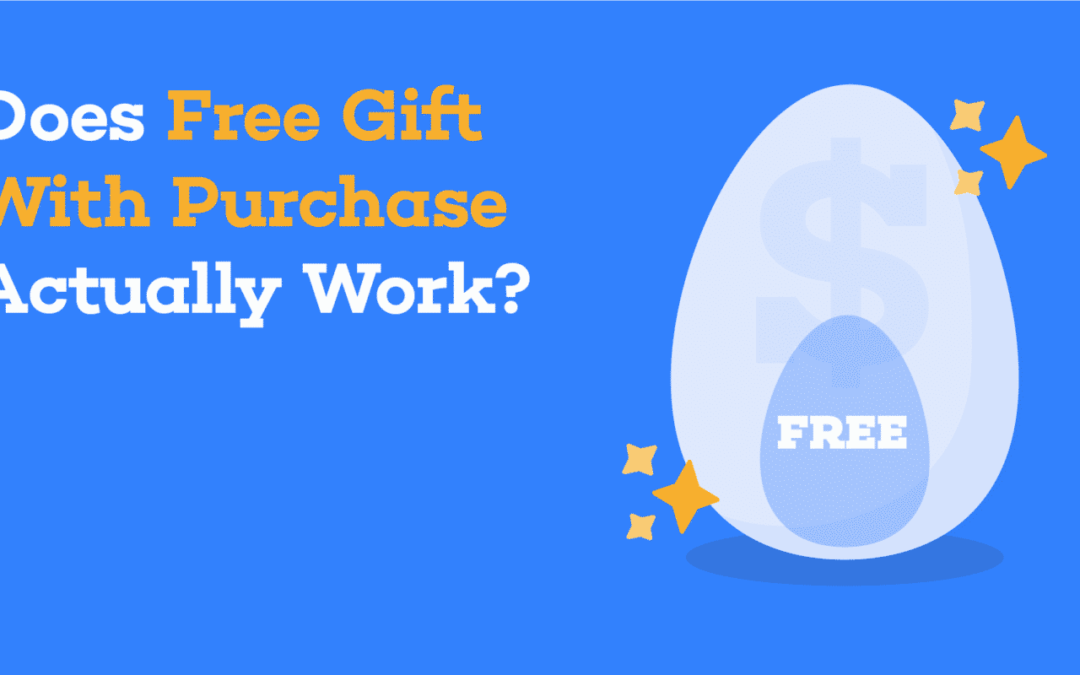
Mar 1, 2021 | Blog, Warehouse Management Software
Today we venture deep into the minds of our customers to answer the age-old, controversial marketing question: does offering a “free gift with purchase” actually do anything?
Spoiler alert: yes, it does… but it doesn’t have the effect that you may expect.
Using case studies and scientific research, let’s look at the psychological effects of the free gift with purchase (GWP) to determine if it’s right for your business, or if there are more effective promotional campaigns.
The “Free Gift With Purchase” Effect
First, why do companies provide a free gift with purchase? What are they trying to achieve?
Online retailers that offer a free gift with purchase (GWP), which is less than 50% of companies, believe that the added value of a free gift will inspire repeat purchases, increase brand loyalty, and stimulate social and word-of-mouth advertising. Companies that offer free GWP include:
Kinder (confectionary) — free toy
Eileen Fisher (apparel) — free organic ditty bag
Bentley (cologne) — free chrome Bentley key ring
And more…
These case studies have been reported by companies that specialize in creating customized GWP for their clients, but do the benefits hold up under scientific scrutiny?
Does GWP Have Scientific Backing?
The answer… yes, but not how you’d expect.
As retailers constantly innovate promotional offers to provide more value to their customers, the “two items for the price of one” sales method has been framed using two distinct promotional tactics: the free gift, and the bundle… and it turns out how you frame the exact same deal actually has different psychological effects on your consumers.
For example, if your business sells household supplies, your promotions could be either:
- “Buy a mop for $20, and get a bucket free!” — the free gift
- “Buy a mop AND bucket for $20!” — the bundle
Studies have shown that bundle offerings and free gift offerings tend to influence the perceived value of products themselves, rather than their opinions of the company offering the gift. Also, the promotional frame has an impact on product return rates!
Effects of Gift with Purchase
With a free gift promotion, the “free item” or “gift” is perceived as less valuable by the customer, while the focal item is valued more. Therefore, customers are less likely to buy the free item after the sale, but more likely to purchase the main item.
Of course, the likelihood of repurchase is directly related to how effective the gift promotion is in increasing the value of the main item, so if that value increases to surpass the customer’s intrinsic repurchase threshold, then they will buy again.
Additionally, with a free gift promotion, customers are less likely to return an item, because the perceived loss of giving back a “free” item is too high.
Effects of Bundle
In a bundle promotion, the opposite is true. The main item is perceived as less valuable, while the bundled item is valued more. Therefore, customers are less likely to purchase the main item as a single item, but the supplementary item is more likely to be purchased as a standalone
With a bundled promotion, customers do not mind returning an item included in a bundle.
TLDR; offer free gift promotion if you want to reduce return rates and sell more of the main product at the expense of the gifted product; offer a bundle if you want to sell more of the supplementary product at the cost of the main product.
In Conclusion
The proven effects of “free gift with purchase” promotion are not proven to inspire net-increase in repeat purchases; rather, the promotion should be used to increase/decrease the perceived value of one focal item at the expense of a supplementary item. Also, the free gift promotion reduces actual return rates as well as the customer’s desire to return.
HOWEVER, these studies imply only the probability that customers purchase again, and this likelihood varies based on the personalization and relevance of the free gift and/or bundle.
That’s why there exists a vast amount of consumer data analysis tools and companies that make large profits off of customized gifts with purchase.
P.S. Children are the Future… of GWP
There does exist a customer group where the free gift with purchase has had immense, proven success: with products geared towards children.
You’re certainly familiar with the Happy Meal toy, which was so effective at marketing to children that McDonald’s was sued by a California mother in 2010 who claimed that the fast food chain used toys to unfairly attract children.
In the listed case study above, Kinder successfully offers a free child’s toy with purchase of chocolate, and there exist highly lucrative marketing teams like Kidoz that offer safe advertising and Gift With Purchase creation for children.
The positive results from a child-facing GWP campaign stem from two main factors:
- Children perceive a free gift as more valuable than adults
- Because adults are the ones delivering the gift to their child, the child’s joy adds to the value of the product for the parent
We’re not saying all GWP campaigns should be geared towards children, it’s just that these are the only ones with a proven record for having net-increases in repeat customers and word-of-mouth advertising (they’re lovin’ it).







